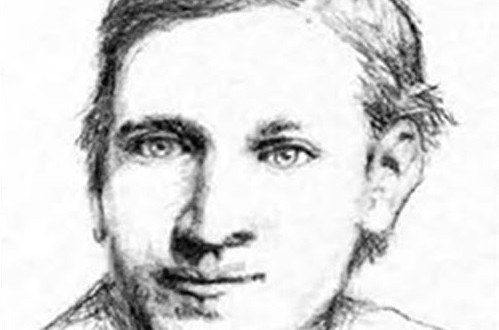BY TOM GREGG

Social reform er/novelist Upton Sinclair averaged a book a year over his ninety-year life. But none matched the impact of his disturbing and controversial 1905 blockbuster about Lithuanian im m igrants in Chicago.
HE WOULD HAVE BEEN JUDGED a failure at most jobs. Yes, on the one hand he’d put himself through New York City College as a precocious teenager in the 1890s, authoring dozens of stories and novelettes. And by his middle twenties he’d also produced four books. But the books didn’t sell, and frequently his work bore signs of the “rush job.” Those signs would be seen throughout Upton Sinclair’s writing.
But as a practitioner in the Arts, Sinclair (1878-1968) didn’t have to be consistently good like most wage earners; he only had to be great once. And agreeably early in a seventy year writing career, he connected in 1905 with the enduring classic novel “The Jungle.” W ithin months of its publication in book form in March 1906, the story of the struggles of a Lithuanian immigrant family in Chicago was translated into seventeen languages, including Lithuanian; worldwide sale ran into the hundreds of thousands. Just as quickly, the book triggered a U.S. government investigation into the alleged public health hazards in the Chicago meat packing plants where many of the characters worked. Validation of the book’s assertions led to the passage of the Pure Food and Drug Act by Congress in June of that year. “The Jungle” thus influenced important national events rather than just reflected them; that puts it on a plane shared by few. While government agents probed in Chicago, critics around the world likewise went to work. Nobody challenged the novel’s energy, clarity, or the effect of its grim, graphic images. Further reviews, however, were mixed. Deducting heavily from the book’s artistic grade, some observed that the book was undeniably slanted. Main character Jurgis Rudkus, while seeming to miss all contemporary pleasures, was personally scarred by most of the social ills of the day: prostitution, child labor, infant mortality, government corruption, abysmal sanitation. That shouldn’t happen to any character, the negative critics argued, any more than a cartoon superhero should stumble on so many felonies while walking the streets. What detractors wouldn’t admit, perhaps even to themselves, was that they were passing other books with flaws in focus or plausibility.
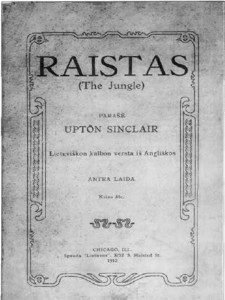
Many low graders were in fact objecting to the politics expressed in the latter half of the book. It’s commonly thought that socialist Sinclair— a longtime proponent as well as a champion of working class causes beginning in 1902— had from the start planned on breaking burly Jurgis physically and psychologically under capitalism before having him see the socialist light. Actually, the author simply wrote himself into a gloomy corner while trying to outline worker problems. That done, he could conceive of no better upbeat ending. Of course, reviewers turning the pages in 1906 didn’t care either way. And judging by surviving critiques, few paid readers in the U.S. were sympathetic socialists, who numbered maybe a million in those pre-Soviet Union days.
Despite a tendency to mislead, the book tells us much about some of our immigrant ancestors and their lifestyle. Penniless in the fall of 1904 in New Jersey, Sinclair was commissioned by the socialist newspaper Appeal to Reason to write a serialized Chicago labor expose/novel that Doubleday would later reprint in $1.50 hardcover form. With a $500 advance from the paper, he spent seven weeks researching on location. By day he roamed the mile square amalgamated meat processing complex called the Union Stockyards. On guided tours he saw how the semi-mechanized system worked, and described the procedures in an early chapter. One particularly demanding job in the operation involved shouldering 250 pound beef carcasses and walking them into a freezer; many of the other functions sound more tolerable. But when one considers that they were done dawn-to-dusk, six days a week, and at a rapid pace, it occurs that most of this work would have been brutal even under perfect conditions.
Flow and where things went imperfectly, Sinclair heard at night in the homes of the barren “Back of the Yards” neighborhood where many of the 40,000 plant workers lived. In 1904 the ethnic makeup of the unskilled help was undergoing a shift to Lithuanian, Polish, and Slovak, the incumbent Irish and Germans having moved up or out. Amid America’s busiest immigration decade ever, sometimes fifty newly arrived Eastern Europeans would be living in a twoflat house built for ten. Home wasn’t plush. But they concentrated on telling Sinclair about filthy workspaces, cuts and blood poisoning, acid vats people fell into, and special rooms where tainted meat would be doctored for human consumption. Sad to say, out of all this it was only the tainted meat aspect that raised the public outcry which brought the government investigators. Hence Sinclair’s famous quote: “I aimed for the public’s heart, and hit it in the stomach by accident.”
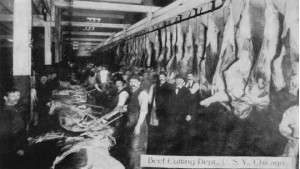
Like his meat packing revelations, his social facts tend to check out. But sometimes facts came into conflict with the story line, and the facts got stretched. Jurgis, for instance, is presented as a nearly friendless and godless man. Despite his lack of hobbies, he frequents none of the numerous saloons in his off hours. He buys a home in a non-Lithuanian section of the neighborhood. Taken together, this would have made him an unusual if not rare individual: ** immigrants understandably tended to stay with their own and/or turn to God in an effort to cope with their strange new world. And Lithuanians were, according to contemporary statistics, even more likely to cluster than most groups, and more likely to be religious. By coincidence, the foundation was being laid for the Back of the Yards Holy Cross Church during Sinclair’s brief visit. The congregation today is much changed ethnically, but their now venerable church was originally built by and for Lithuanians. Sinclair, however, essentially walls Rudkus off from everything to heighten the sense of isolation as his fortunes turn sour.
It must have been tempting for Sinclair to cheat too on the Lithuanian details found in the book’s early chapters. He liked to work fast; he wasn’t selling Lithuanian culture; authentic background wasn’t expected in novels a century ago. Besides, who’d know if he got some ethnic trivia wrong? Less than half of the incoming Lithuanians were literate. Fewer could read English. And fewer yet were reading popular literature. But he knew his chances of changing social conditions depended heavily on painting as faithful a picture of existing life as possible. And so he did admirably well by us, beginning with the Lithuanian veselija (wedding feast) in the opening chapter.
Biographer Leon Harris called it the best scene Sinclair ever wrote. Of its derivation, Sinclair himself wrote in his 1962 autobiography, “At the end of a m onth or more [of research in Chicago], I had my data and knew the story I meant to tell, but I had no characters. W andering about ‘Back of the Yards’ one Sunday afternoon I saw a wedding party going into the rear of a saloon… I slipped into the room and stood against the w all… There were my characters— [Ona] the bride, [Jurgis] the groom, the old mother and father, [Marija] the boisterous cousin, the children, the three musicians, everybody.”
There, too, as Sinclair painstakingly described in “The Jungle,” were the roast duck, steamed potatoes, and sauerkraut, and the drinking and native dancing that typically lasted until four A.M
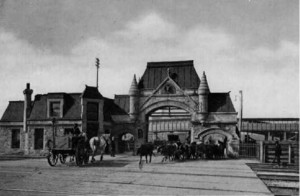
Rightly or wrongly, he injected an undertone of anxiety even into this gay proceeding. The couple’s family worried about how they would pay for the feast; the bar bill alone was going to be staggering. Many guests dreaded having to face Monday in the Stockyards; work started at seven sharp. The seniors agonized whether their old world customs could survive in America; even as matters stood, because of job commitments the post wedding rites had needed to be compressed from several days to the one twelve hour stretch.
A self-taught master of French, Italian, and German, Sinclair smoothly worked a fair amount of Lithuanian language into chapters one through six before the characters’ Americanization took hold. Running all sixty-some words through an heirloom Lithuanian-American dictionary printed in 1915, we can account for all but one. Marija’s lines at the veselija are easily the most poignant. She requests an unfamiliar Lithuanian song of the musicians, a broken heart melody. To clue them she sings in part: Jog vargt ant svieto reik vienam. One has to suffer on this world alone. Most every Jungle character certainly would.
Except for the vocabulary runthrough, anyone can arrive at this point in knowledge with trips to a few well-stocked libraries. But to ethnic points beyond there’s a significant obstacle: all of Sinclair’s preparatory notes on “The Jungle” were destroyed in a 1907 fire. This leaves researchers dependent on his personal correspondence, the bulk of which now resides at the University of Indiana library. Somewhere in that intimidating eight ton mass of material, Sinclair may have addressed the following issues, although more likely not. One is always free to speculate, however, based on information at hand.
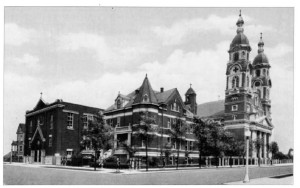
Why did Sinclair choose Lithuanians as subjects? His autobiography mentions his chance encounter with the wedding party, no more. And maybe that alone persuaded him to cast Lithuanians rather than Poles or Slovaks in his bestseller. But then again, we could have had an inside track due to earlier developments. Sinclair was probably introduced to his future focal group no later than 1898, when Lithuanians massed in New York City to protest U.S. government disregard for new immigrant welfare. Being a graduate student then at local Columbia University and having already exhibited a social conscience, Sinclair was almost certainly aware of the rally. He’d remember the demonstration later, too, when he’d hear of Lithuanian immigrants being typed as particularly strong, hard-working, thrifty, and keen on labor union activities. The profile would be useful to the author in “The Jungle”: the strength, hard work, and thrift of the Rudkus family enhanced the sense of tragedy with their downfall, and the outspokenness of Jurgis and Marija as labor union members facilitated that downfall.
Where did the names o f the characters come from? The names are authentic, at any rate. Having had no significant contact with us previously, Sinclair very likely produced them by tapping the rolls of the many local Lithuanian social and religious organizations. “Rudkus,” however, may have been different; unlike with the rest of the Jungle cast, nothing on the Internet today confirms its validity. William Hoffman, editor of the acclaimed Lithuanian Global Genealogy Society newsletter Proteviai, consulted some specialized sources before concluding that it’s a legitimate name akin to the more prevalent Rutkus. Hoffman, author of four books himself, is not surprised at the selection. “Aesthetically, Rudkus feels and sounds Lithuanian, but is rare enough that the average reader would not be distracted by associations with real Rudkuses he had known,” Hoffman says. “Practically, a rare name may also be preferable so the author will not be plagued with complaints from real people who resent having their names used.” Conceivably Sinclair had a knowledgeable Lithuanian produce a legitimate strong-sounding name for him or— given his feel for phonetics from the study of four languages— “invented” one himself.
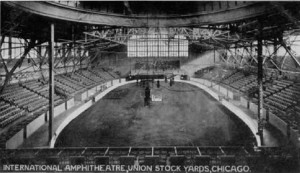
Who were the bride and groom? Sinclair may never have bothered to learn, and odds are high against there being anything pertinent at the U. of Indiana. The alternative research approach isn’t much better. Based on the autobiography, the wedding occurred in early/mid November 1904. Assuming the couple was Catholic, the ceremony would most likely have been at the now closed St. Rose of Lima Church. Serving Englishspeaking Back of the Yards residents, St. Rose was a temporary home for the fledgling Holy Cross congregation July 1904 to June 1905 while the Lithuanians’ own building was constructed. As with all defunct Chicago parish data, St. Rose marriage records now rest in Archdiocese archives downtown. Out of those records one would likely find a dozen leads across three Sundays. And possibly from those dozen leads one might trace a descendent with a yellowed wedding portrait of the bear-like model for Jurgis and the contrastly diminutive blonde prototype for Ona. Or it could easily have been a different church entirely, or all the relations are dead or have hopelessly common surnames. In another hundred years we may still be reading “The Jungle” and wondering.
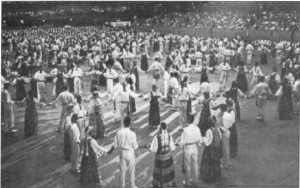
 DRAUGAS NEWS Lithuanian World Wide News in English
DRAUGAS NEWS Lithuanian World Wide News in English
